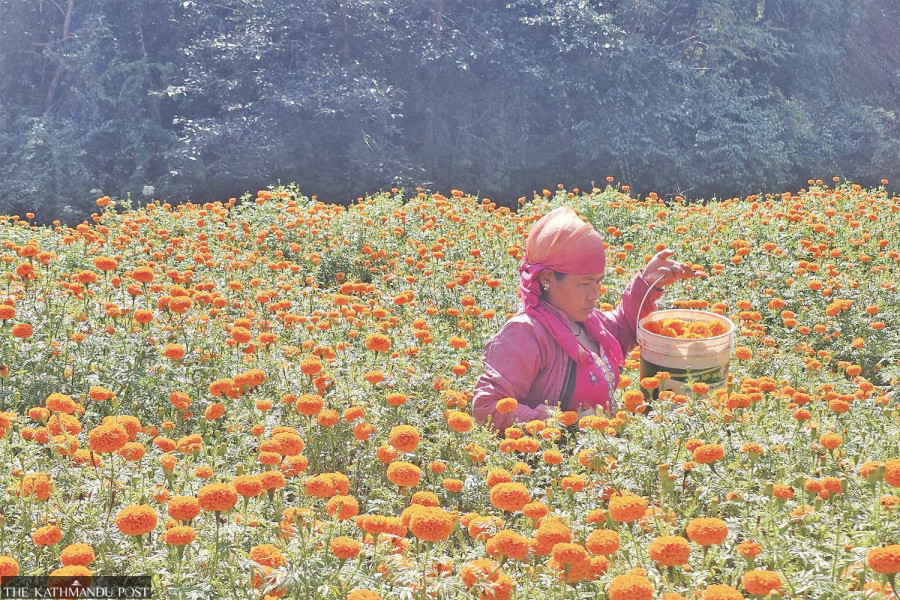Bagmati Province
Gulf returnee turns flower farming into lucrative livelihood
Madhav Ghimire of Banepa cultivates a hectare of land with marigold and other flowers, netting around Rs 1 million a year.
Jyoti Shrestha
At a glance, the fields of Basdol in ward 12 of Banepa Municipality glow golden under the autumn sun. As the country’s major festival Tihar is round the corner, the marigolds (sayapatri in Nepali) are in full bloom, announcing the season of lights and garlands. In the middle of this bright stretch, 58-year-old Madhav Ghimire is busy plucking flowers with his workers and family members. Their hands are moving swiftly from plant to plant.
Every year, the festive season around Dashain and Tihar is Ghimire’s busiest time. Demand for flowers surges during the festivals, mainly during the Tihar. He spends his days harvesting, sorting, and sending truckloads to nearby markets. “This has become my life,” said Ghimire, smiling as he arranged freshly picked marigolds. “From morning till evening, I’m either planting, watering, or harvesting.”
Originally hailing from Morang, Ghimire spent 18 years working in Saudi Arabia. Later, he moved to Israel, where he learned commercial flower cultivation—a skill that transformed his life. “All I really knew was how to make things grow—flowers or vegetables. I thought, why not try it back home where I belong?” he said.
Four years ago, he returned to Nepal and leased 20 ropani [1.02 hectare] of land in Banepa to start marigold farming. He cultivates hybrid varieties imported from Japan and Thailand, known for their bright color and longer shelf life. He started small, with just five ropani of land. But after realising the potential of Nepal’s expanding religious and festive flower market, he expanded.
“There’s a temple almost every 50 metres in Kathmandu. Each one uses at least five kilograms of flowers a day. So, the demand is endless,” Ghimire explained. Today, Ghimire tends to around 20,000 marigold plants.
Flower farming, Ghimire says, requires far less effort and investment compared to other crops. “Only 15 to 20 percent of total income goes into expenses,” he asserted. Last year, he sold about 3,000 kilograms of marigolds at prices ranging from Rs200 to Rs400 per kilogram, making a net profit between Rs800,000 and Rs1 million.
This year, he expects an even better yield. “The flowers have bloomed beautifully, and the market price is higher,” he said. With prices ranging between Rs400 and Rs600 per kilo, he estimates selling up to 7,000–8,000 kilograms this season.
Ghimire has already sold 2,500 kilograms during Dashain alone, earning about Rs500,000. “By the end of Tihar, I expect my total income to reach Rs1.6 to 1.7 million,” he said, adding that his total investment so far this season is around Rs300,000–400,000.
Despite its promise, flower farming is not without challenges. “The weather plays a big role. Too much rain ruins the blossoms, and frost can destroy everything overnight,” Ghimire said. According to him, proper care—from timely weeding to pest control—is key to maintaining quality.
The Kathmandu market remains his biggest buyer, with wholesalers and individuals flocking directly to his farm when demand for flowers is at its peak. “Sometimes people come straight here to buy,” he said. “During Tihar, I can hardly keep up with orders.” Social media, too, has boosted his business. Locals have been sharing photos and videos of his flower beds, drawing more visitors and customers. “People are surprised when they see that such commercial flower farming is possible in Nepal,” he said.
In previous years, local growers struggled to compete with cheap marigold imports from India. Domestic farmers had often complained about the influx of imported flowers during festive seasons, which undermined local production. Last year, however, the government temporarily restricted imports — a decision that gave Nepali farmers like Ghimire a much-needed market boost.
“When imported flowers were banned, our produce finally found buyers. That’s when I realised this can be a sustainable business,” said Ghimire. He believes Nepal could meet much of its own floral demand if the government supports small farmers through subsidies, training, and market management. “If authorities help us manage distribution and continue restricting unnecessary imports, local flower production can thrive,” he said. “There’s no reason Nepal should depend on foreign flowers for its festivals.”
For Ghimire, who once laboured in the deserts of the Persian Gulf, the sight of his golden fields is reward enough. “I went abroad for money,” he said, gazing across the marigolds swaying in the breeze, “but I found real satisfaction only after returning home and making these flowers bloom.”




 8.12°C Kathmandu
8.12°C Kathmandu











